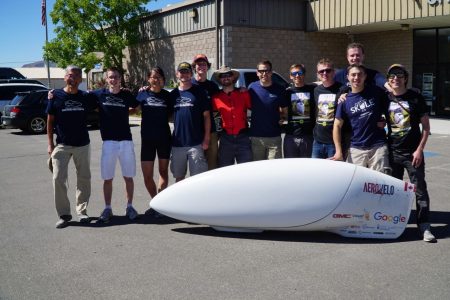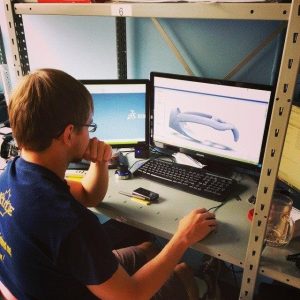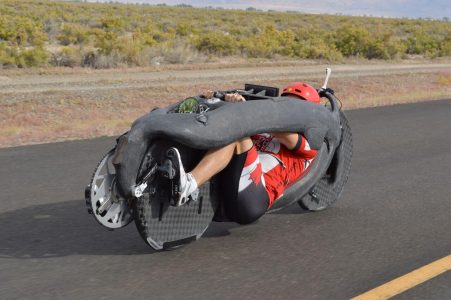Combining pedal power and innovative engineering to break a world record
[sharexy]

Aerovelo members, the U of T Human-Powered Vehicle Design Team and their faculty advisor, Professor Jun Nogami (far left), with their world record-breaking speedbike, Eta (Photo: Danny Guthrie / Jun Nogami)
October 02, 2015 | By Tyler Irving and Luke Ng
On September 19, 2015—Aerovelo—a team of University of Toronto Engineering alumni and students broke the world record for the fastest human-powered vehicle. Eta, their 25-kilogram fish-shaped speedbike, reached a speed of 139.45 kilometres per hour at the World Human Powered Speed Challenge in Battle Mountain, Nevada.
It all boils down to one word: efficiency.
The feat is impressive enough, but even more so when you realize that more than a dozen teams have been competing at Battle Mountain annually for the last 16 years.
So how exactly did the team get the edge they needed to crack the world record? It all boils down to one word: efficiency.
The average top speed on the Tour de France, where the world’s top cyclists ride extremely expensive and well-tuned bicycles, is between 40 to 50 kilometres per hour. That’s about one-third of Eta’s top speed, so why the difference?
“It’s an evolution of convergent design—you end up with a shape that vaguely looks like a dolphin any time you need an object to move easily through a fluid.”

HPVDT captain Calvin Moes working on Eta’s frame design (Photo: Aerovelo)
“Professional cyclists spend a lot of money on acquiring the lightest bike frames just to shave a few grams off their overall weight, but it’s air resistance that really slows them down,” said Calvin Moes, a materials science and engineering (MSE) MASc candidate and captain of the U of T Human Powered Vehicle Design Team (HPVDT), the student arm that collaborated with Aerovelo on the design and construction of Eta. “But their equipment is tightly regulated by traditional racing rules whereas we are not.”
Being able to think and design outside the box is how Eta and its fellow speedbikes get around this problem. They encase their bikes in an elongated aerodynamic shell, known as a fairing. Its shape and curved surface allows air to slip past it smoothly, similar to fish swimming through water.
The team used carbon fibre reinforced polymer and a unique molding process to make the fairing surface as smooth and free of imperfections as possible.
“It’s an evolution of convergent design,” said Moes. “You end up with a shape that vaguely looks like a dolphin or tuna any time you need an object to move easily through a fluid.”

Eta being tested on the road (Photo: Aerovelo)
In order to construct the aerodynamic shape, the team used carbon fibre reinforced polymer—a lightweight and strong composite material—to build the fairing. They deployed a variety of techniques—including a unique molding process to make the fairing surface as smooth and free of imperfections as possible.
“We learned a great deal based on past experience about how minor incursions in the surface could slow the bike down,” said Moes, referring to Bluenose, the team’s previous vehicle, which was built for the World Human Powered Speed Challenge back in 2012. “We also adjusted the carbon fibre curing procedure that resulted in a notable weight reduction in Eta’s fairing.”
Some other improvements included super-hard tires that don’t stick to the road as much and a gearshift designed to minimize energy loss to friction, heat and sound.
“Sustainability includes making our technologies more efficient and Eta is a perfect example of how vital materials engineering is in achieving that goal,” said Professor Jun Nogami, chair of the U of T Department of Materials Science & Engineering and HPVDT’s faculty advisor. “I’m delighted that our students had this unique opportunity to apply what they’ve learned and to help Aerovelo make a piece of history along the way.”
What’s next for the team? They’re working with a Toronto-based company that has the ability to coat any material with an ultra-thin layer of nickel. The result—coated parts primarily made of plastic or composites that are lighter than the metal components they would replace.
They might break their own record again next time.